
It’s no surprise that the process of designing, testing and building ATVs, UTVs and snowmobiles has evolved with the introduction of the microchip. One area of evolution is the ability to measure and collect data about what’s happening with virtually every aspect of a vehicle.
Adam Kuiken is one of the Arctic Cat engineers whose job is to develop and collect test data during product development. Kuiken’s official title is Senior Test Engineer, a position he’s held for five of the eight years he’s been at Arctic Cat.
He was kind enough to explain his job and how it affects the vehicles we own.
AI: Okay, let’s start by you telling us what it is you do as a Senior Test Engineer, then we’ll dive a little deeper into the nuances of your job and how it translates into building ATVs, UTVs and snowmobiles.
Kuiken: My description is Senior Test Engineer. I develop and design test procedures and fixtures, conduct tests, and gather and analyze data from the testing of ATV’s and Side-by-Sides and occasionally snowmobiles for new product development. This includes both in-field testing and lab testing of both complete units and subsystems.
AI: What’s your educational and professional background, and when did you first start doing this work with Arctic Cat?
Kuiken: I have a bachelor’s degree in Mechanical Engineering with a minor in Mathematics from the University of North Dakota. I started out professionally as a Stress Engineer for the Goodrich Corporation doing testing and analysis on large commercial aircraft such as the Boeing 767, 747 and Airbus A380 and A330. Three years later, I started at Arctic Cat as a design engineer specializing in plastic design and cooling systems. I transitioned into the testing role over a couple of years as that is what my background and passion was. I have been doing full time Test Engineering since roughly the end of 2008.
AI: How do you split your time between the various product categories?
Kuiken: Most of my work is focused on our wheeled vehicles, but I occasionally help with snowmobiles, including work on the torque link, driveline and some other engine stuff.
AI: Are there other people who work in a similar role/capacity as you?
Kuiken: There is a technician and a young test engineer who work with me. Both are extremely hard working and a lot of fun to work with. I couldn’t do my job without their help.

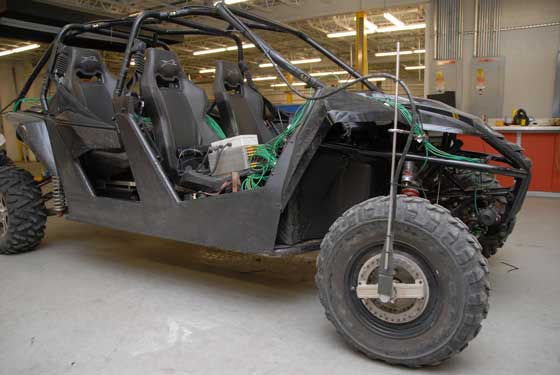
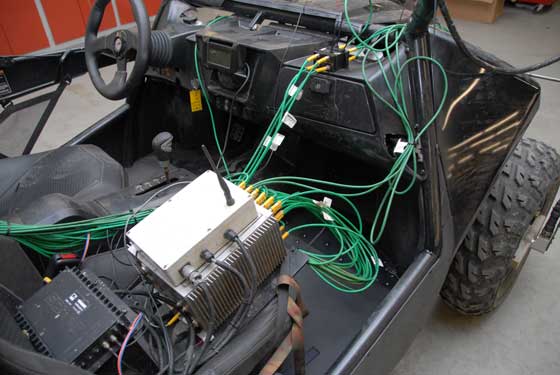
Above, Kuiken checks on the data equipment hooked up to a prototype Arctic Cat Wildcat 4 during its development stage.
AI: If I understand correctly, you role is primarily data acquisition, correct? Or are you also interpreting that data?
Kuiken: Data Acquisition is a big part of my job, but so is interpreting it. I have to be able to break down the data into a form that the designers and stress analysts can use.
AI: How is the data used once it’s acquired and interpreted?
Kuiken: Much of the data is used directly by the designers to answer questions that come up during the development phase of a new vehicle. Questions such as, “How much load does this shock absorber or tie rod see?” or, “How hot does this side of the fuel tank get?”
Other data is used by the stress analysts to ensure that the computer models they build and analyze are accurate and consistent with what happens in the real world.
Some of the data I gather is even used to help improve quality or to help analyze an unexpected failure.

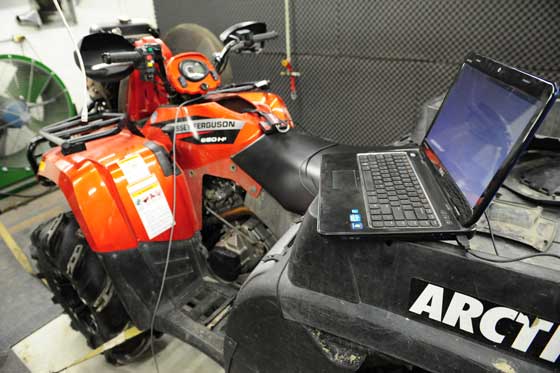
Here’s an Arctic Cat TBX (in Massey-Ferguson livery!) set up on a chassis dyno and outfitted with data acquisition equipment.
AI: How does this help improve Arctic Cat products?
Kuiken: As you know, engineering is always a compromise between quality, price, and time. There is an old saying among engineers that anyone asking for any widget can have it cheap, fast, and high quality as long as they only pick two. The data I collect directly helps the engineers design parts that are as cost effective for the consumer as possible, as strong, light weight and as durable as possible, and get to the market as fast as possible. The data allows them to make the best possible design decisions so our product is the best on the market.
AI: What are some of the various types of data acquisition tools that you use?
Kuiken: We use a variety of equipment… everything from simple load cells, pressure transducers, and thermocouples to elaborate data loggers with Military grade GPS systems that can track a vehicle to within tenths of an inch.
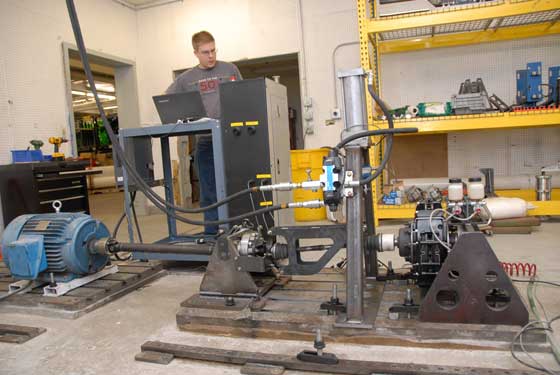
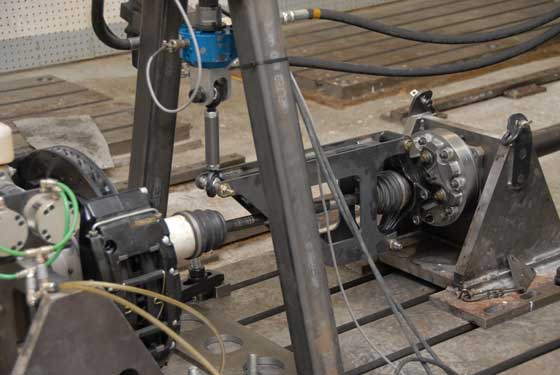
Here’s a test rig that Kuiken set up to analyze ATV/UTV axles.
AI: Give us some specific types of data acquisition that you’ve been involved with on products that you can actually talk about?
Kuiken: One of the more interesting projects I worked on was a study of the motion of the read valves in the 800cc 2-stroke engine. I applied a strain gage to each pedal of the reed valve and then we recorded the displacement of the valve as the engine was run on a dynamometer. I was collecting the position of the pedal at 10,000 times per second and this allowed us to see exactly how and when each pedal was opening. It was very interesting to see how much they actually fluttered and moved around.
We actually started taking load data on the Wildcat side-by-side back in July 2010 with the very first prototype. This too was a very interesting project as it was a completely new chassis for us and the weight, power and suspension of the vehicle was unlike anything Arctic had ever done before. We spent quite a bit of time that summer in both the Southern California desert and the Iron Range of Minnesota taking suspension, steering, driveling, and chassis loads.

Wiring to the Prowler’s brake caliper indicates yet another assembly whereby engineers “see” and learn about.

All data is recorded, after which it’s downloaded for analysis. According to Kuiken, it’s the interpretation and analysis that’s the most difficult and time consuming elements of his job.
AI: Wow, to me it’s pretty amazing that you can measure or “see” inside the intake of an engine and watch the reed valve. Is there any component, assembly or area of Arctic Cat products that you can’t yet gather data?
Kuiken: Yeah, the way it worked in that case was that we used a strain gage that created a change in voltage that was proportional to the deflection of the reed valve. I was then able to watch and graph the position of the reed valve over time or as a function of crank position. However, we do now have a very high-speed camera that has gotten a lot of use during testing that allows us to literally see inside of places. We have used that to watch everything from starter engagement on the H2 V-Twin to clutch vibration on the Z1 Turbo.
There isn’t much we can’t gather data on. Even gathering strain data on rotating components on the inside of an engine – such as the crankshaft, rod and camshaft – is difficult and expensive, but not impossible. Analyzing the data is typically more difficult then gathering it.
AI: Prior to using these techniques, how would Arctic Cat have solved some of these problems? In other words, how did they do it in the old days?
Kuiken: Before, they would simply ride until something broke, fix it and then ride some more until the next part broke. The problem was, the part that would break always depended on the rider, the conditions, or the terrain. Seat-of-the-pants testing is fine to a certain point, but you can change the results just by changing your pants. Today the designers have the data and information to design a vehicle that is much closer to a finished product right out of the gate. Quite often our first build of a new vehicle will go through the first 125 hours of field test with only minor problems and issues. We still do extensive field testing, but we have the equipment to ensure that the riders are putting the vehicles through scenarios that cause similar amounts of damage. This makes our testing much more accurate and speeds it up, helping to get the vehicle to market quicker.
AI: What kind of technologies do you use to fulfill your role, and how are those technologies changing?
Kuiken: I use a lot of computing power, wireless data transmission, GPS, and control technology. The biggest changes I see are in the amount of data that can be collected and processed, the accuracy and size of the instruments, and their ease of use. Fifteen years ago, data loggers and transducers had to be manually programmed. Today everything is moving to plug-and-play technology. The instruments are getting much smaller and more accurate. There are very fast, durable and accurate Data Loggers now on the market that are about the size of a check box that can read dozens of channels and have high speed GPS and wireless data transfer built right into them.
AI: Is there a “new frontier” to your field, something that you’re not doing now but probably will be in 5-10 years?
Kuiken: Highly Accelerated Lifecycle Testing or HALT is fairly new paradigm in the world of testing. The biggest advantage of this would be the ability to produce vehicle iterations much quicker. What I mean by that is, currently it takes us 6 to 8 weeks to put a 125 hr duty cycle on a machine in the field. Depending upon the project, Engineering will produce 2 to 4 vehicle builds before final production begins, with 6 to 8 months between each of those builds. With the HALT methodology and equipment, we should be able to simulate that 125 hr duty cycle in 2 or 3 days. That will allow us to build a prototype, test it, make changes, and start retesting much quicker and more often during 6 to 8 months between builds. This should allow us to eliminate a build or 2, shortening the process. It will never eliminate field testing, but it will allow the engineers to build a much better, higher quality prototype that is closer to production intent to begin field testing with.
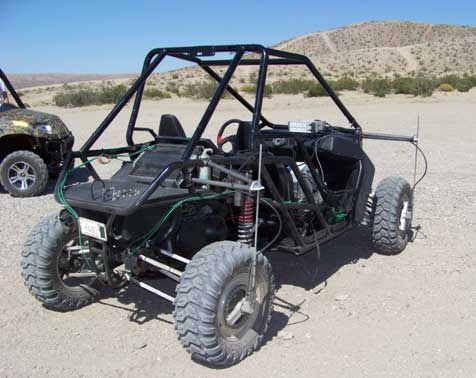
This is the first Arctic Cat Wildcat prototype, shown here instrumented with Wheel Force Transducers and suspension loads… about 50 data channels in all.
AI: Does data acquisition apply mostly to real-world testing, or are you also using it during Dyno testing?
Kuiken: Both. It’s very important to know what is occurring in the field so that it can be reproduced on the dyno and in the lab. Also, we can take data from the field, then reduce it to its most damaging components and reproduce those damaging events on a dyno or in the field. This enables us to put a test subject through several lifetimes of abuse in a much shorter period of time.
AI: It seems like every time I see you in ATV engineering, you’re fabricating some type of test rig. Tell us about some of the kinds of test jigs, resistors and such that you’ve been part of?
Kuiken: Like I said above, it is very beneficial to be able to repeat the highest stress scenarios in the lab, because we can try a bunch of different things quite quickly. Because of the fact that we build many different types of vehicles, it seems I am always working on a different fixture. Some of the fixtures I have built are for fatigue testing hubs, A-arms, knuckles, gear cases, steering shafts, frames and other similar components.
I have also designed and built test rigs to study both engine and clutch air intake performance and dust intrusion. I’ve built dynamometers for water pumps, gear cases, and clutch systems in order to understand performance, noise and durability. Plus I’ve also built impact fixtures for strength testing of a wide variety of components.
The never ending variety of test rigs and the chance to always improve both the test itself, and the final product is a big part of what makes my job so enjoyable.
AI: This is all very cool… thanks for taking the time to explain what you do.
Kuiken: You’re welcome.



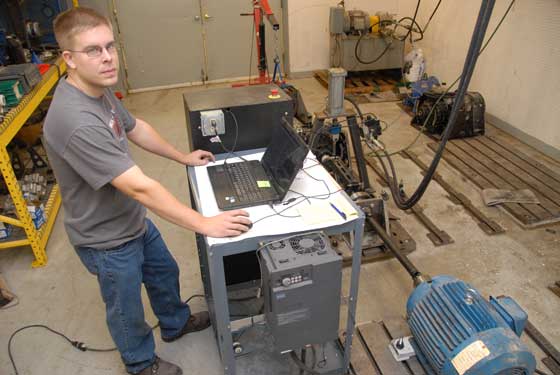
Hey John! Is that mike P’s tbx from engineering that won in hill city mud nationals??
when adam says its more difficult to analyze the data than it is to record it, reminded me of all the gopro helmet footage i have but that i seldom look at.
adams job sounds interesting and both mechanical/computer. seems like a good combination especially if it means we get new snowmobiles faster and for less money.